Do Fishing Spiders Make Good Pets – Everything You Need To Know
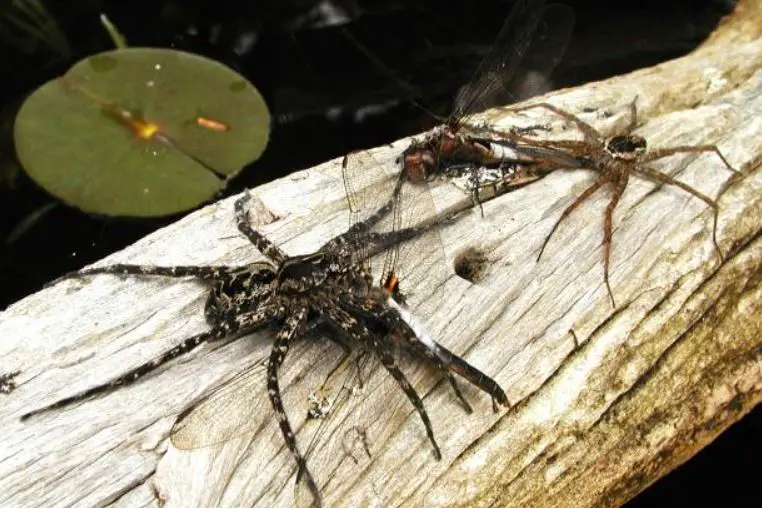
Fishing Spiders are found chiefly around bodies of water.
But, these spiders can be found in not only water sources but in wooded areas too. Fishing Spiders don’t even need a web to catch their prey.
Where Do They Come From?
The Fishing Spider’s scientific name is Dolomedes and is known by several other names too. These names are raft spiders, wharf spiders, or dock spiders.
The spiders are found mainly in Mexico and Canada. The Dark Fishing spider can be found from southern Canada west to North Dakota and south to Florida and Texas.
Where Are They Found?
The Fishing Spider is found in the woods, underwater, and under rocks. This species of spider doesn’t build webs to capture prey. Instead, the spiders roam around and eat a variety of food sources in water, on water, and on land.
These spiders can actually run across the surface of a stream or pond. When they see prey, they dive in and remain submerged for several minutes. While submerged, they hunt small fish and tadpoles using their fangs and sharp claws.
What a Fishing Spider is All About
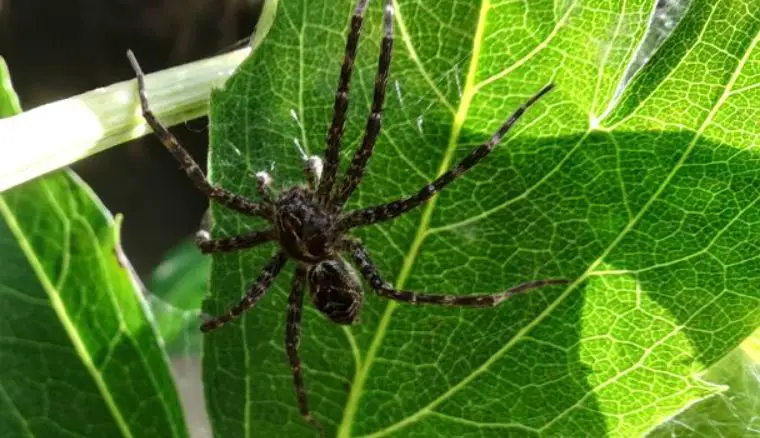
Size
The female Fishing Spider measures about one inch in the body with a leg span of three inches. They weigh between 0.04 to 0.05 ounces and are about 0.59-1 inch tall.
The body is grayish-brown and has black markings. The legs are banded, but there is variation in individuals. The male is only half the size of the much larger female.
Depending on what species your Fishing Spider is, the color can also be a variety of browns, grays, or greens with different patterns.
Personality
They are shy and somewhat solitary. Your spider isn’t known to be aggressive. These spiders only bite when they are provoked. Usually, your spider will run and hide. Or she will collect air bubbles through her hair and hide underwater.
Life expectancy
Most Fishing Spiders will live about two years because they hibernate. The time to find a Fishing Spider in nature is between May and September. If your spider is a female, she will live for about two years. If you have a male, he will live for about a year and a month.
If you mate your Fishing Spiders, the male will die after mating. Sometimes the female spider will eat the male. The reason for this behavior is unknown.
Family pet
Compared to other pets, a Fishing Spider is easy to care for. Learning the proper way to handle your spider will help you determine what supplies you will need. Your spider will need to live in a terrarium for it to thrive properly.
Fishing spiders do have a scary appearance because it’s one of the largest types of spiders you can find in the United States. But they are reasonably easy to care for and will live happily in a 10-gallon tank with lots of live plants and a small container of water for them to hide in.
Price
The price of a Fishing Spider is between $20-$50
Tips for Raising a Fishing Spider
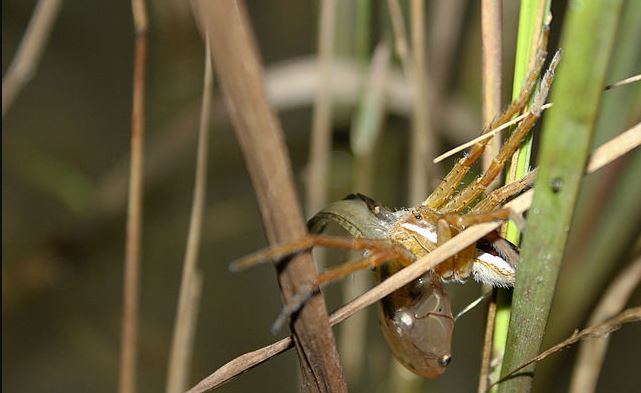
Your fishing spider will be great in a terrarium with lots of space, live plants, a small pool of water, and upright cork bark slabs. A ten-gallon tank is a good size for your spider.
When you have the perfect setup, your spider can show off its hunting skills when leaping and capturing flies or moths. If the water pond is large enough, you can even put tiny fish in it for your spider to eat.
Your Fishing Spider will have a hearty appetite. It will eat tadpoles, small fish, and insects, and insect larvae. Your spider will eat up to five times its own weight daily.
If your female Fishing Spider is pregnant, she can carry up to 1,400 eggs. The eggs are in an egg sac suspended between the chelicerae, which is her fangs, and the spinnerets.
When the incubation period has ended, the female will construct a web. Then, she will suspend the egg mass in the web. This is where the alternate name of Nursery Web Spider comes from.
Your female will stay with hatchlings for a while to defend them against any predators. She may refuse food and protect her brood from crickets or any other moving insects you placed for food.
Keeping your terrarium moist will benefit your spider. If there are babies, they definitely need to be kept in a humid enclosure.
What is their behavior like?
Your spider won’t be shy about feeding during the day, but they are more active at night. A red reptile bulb is a great way to see them at night.
The Fishing Spider is shy and, if startled, will hide. You will have to start gently if you want to handle your spider. Not all of these spiders enjoy being handled.
Do they bite?
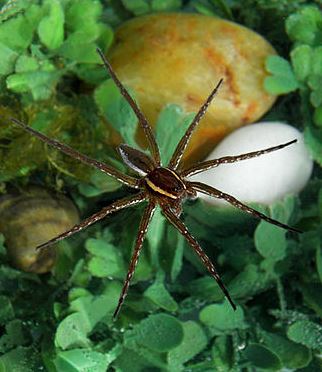
This type of spider is venomous.
But, unless you’re allergic to it, the venom is harmless. The bite is said to be similar to a bee sting.
Interesting Fishing Spider Facts
Walking
The Fishing Spider has three gaits. The first gait is when the tip of each leg touches the water. The legs make a small dimple or indentation. With the weight spread over the tips, the spider doesn’t break the surface tension of the water.
So, she won’t sink. When she moves, she makes a skating motion and technically walks on water.
In the second gait, the spider moves faster. She will move her two-middle pair of legs like a paddle. This movement will allow her to move about one foot per second.
With the third gait, she can run really fast. The spider will move her legs, similar to how a person does. She will lift each waterproof leg and push it into the water. This movement causes an opposing force that propels the spider forward as she raises her other legs in succession.
Solitary
A Fishing Spider likes to live a solitary existence like the other spider species. But you can place an adult male or female with the batch of nursery web spiders.
The Fishing Spider likes to live alone most of the time, but the Nursery Web spiders can stay with their parents until the first molt.
Hunting
When a Fishing Spider is hunting, it may rest with its back legs on a piece of floating vegetation or wood. It will have its front legs resting, just barely touching the water’s surface.
The spider can then detect any surface waves on the water, which lets them locate potential prey. If the spider detects prey underwater, they will use their back legs to push off the vegetation or wood and dive after the prey.
Your spider will also dive underwater when it’s startled. Your spider can stay underwater for up to a half-hour. It can breathe underwater because its lungs are located on its abdomen.
The abdomen is covered with tiny fine hairs that trap air. The hairs with trapped air form a sort of diving bell which lets the spider breathe while underwater.
How do Fishing Spiders communicate?
Fishing Spiders communicate through vibrations. These vibrations are known as seismic communication. Through different levels of vibration, the spiders can catch prey or warn rivals.
Some Fishing Spiders prey on other spiders by mimicking the sound of insects. This is why the Fishing Spider doesn’t need a web to hunt its prey. The waterworks as a web for them since they can feel the vibration of their prey landing or falling into the water.
Fishing Spider Vs. Wolf Spiders
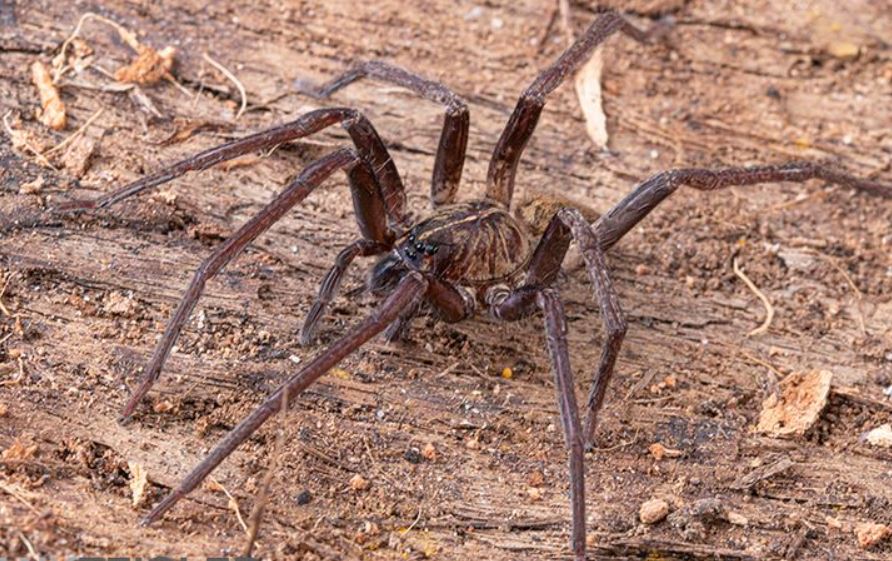
Fishing spiders are sometimes confused with another spider called a Wolf Spider.
The two spiders are similar in appearance by having the same body type. They both have black or brown exoskeleton with black or brown bands around their bodies. In addition, two kinds of spiders have hairy bodies so they can walk or swim on water.
The difference between these two spiders is that Fisher Spiders have a larger bodies.
This is because Wolf spiders have eyes of equal size, and fishing spiders have different-sized eyes. Plus, a Fishing Spider has eyes that are arranged differently.
The Fishing Spider has four eyes which are arranged in two horizontal rows.
The Wolf spider comes inside looking for a warm place to hang out in the winter, usually in basements, on windows or doors, and in garages. If they are outside, they will be on the ground searching for bugs to eat. Wolf Spiders will bite you if handled.
Fishing Spiders are usually found near water or in moist woods native to the eastern United States. However, they will sometimes be located indoors or will climb on outside walls. Fishing Spiders will bite if startled.
Conclusion
If you want to have a spider as a pet, the Fishing Spider may be the perfect pet spider. You just need to set up the proper habitat and feed your spider the right food.
Learning your spider’s habits up close and personal can start you on a journey that you will enjoy.
If you want to learn more about fishing spiders, please click the video below:
https://www.youtube.com/watch?v=tHU9wEJAec4
References:
https://sercblog.si.edu/the-everyday-naturalist-fishing-spiders/
https://kidadl.com/animal-facts/fishing-spider-facts/
https://www.slugabug.com/2015/04/27/everything-you-need-to-know-now-about-fishing-spiders/
https://cutehomepets.com/fishing-spider-facts/
https://www.everythingreptiles.com/12-best-pet-spiders/#8_Fishing_Spider


